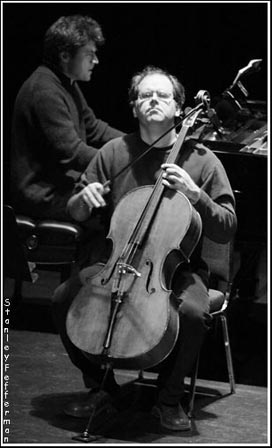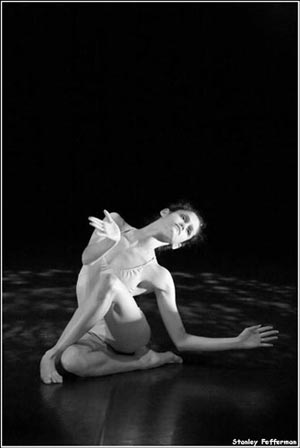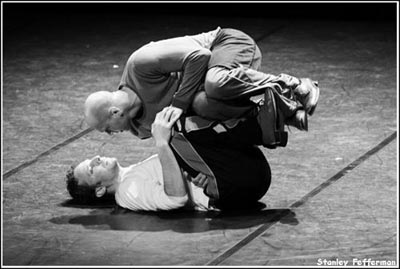 |
| Art of Time Ensemble | Music and Dance |
|
| February 3 & 4, 2006 • Harbourfront Centre Theatre • Toronto |
|
|
|
|
|
|
Duet: Clouds from Both Sides
by Stanley Fefferman |
| Piano and Dancer
The enjoyment of music and dance could be as simple as appreciating the play of clouds in a bright sky and the glide of their shadows over the hills. The first piece was choreographed by Peggy Baker in 1995 to John Cage’s In A Landscape (1948). It embodies the mystery of energy flowing in a closed system.
Pianist Andrew Burashko plays Cage’s “serene ambient music.” Burashko lets the music float up from the piano and fall softly as reflections of starlight on an alpine brook. Tanya Howard folds and unfolds herself like an origami crane standing in a moonlit pool. Marc Parent’s lighting allows Ms. Howard’s silhouette to dance beside her like an animated poster by Toulouse-Lautrec. Her movements indicate silence, his music rests in stillness. Applause!
|
|

Thomas Weibe (cello) & Andrew Burashko (piano |
|
|

Tanya Howard |
|
|
|
|
| Piano and Cello
Prokofiev’s Sonata for Cello and Piano in C Major, Op.119 is weightier matter. After 16 years of brilliant success in Paris, Prokofiev was driven by homesickness to return to the Soviet Union at a period when musicians were being watched over by Stalinist apparatchniks for signs of formalistic decadence. The strain of this harassment and some concessions to it began to show up in Prokofiev’s symphonies. Around 1949, the young cellist Rostropovich suggested to Prokofiev ideas on infiltrating cryptic, personal messages into his compositions to restore their honesty. Prokofiev’s biographer Michel Dorigné describes the resulting Sonata Op. 119 as an “ultimate act of atonement in the eyes of posterity, the musical testament of a wounded man.”
As performed by Thomas Weibe on cello working in balance with Andrew Burashko on piano, this oeuvre shows a wonderful freedom of form. The three movements take improvisation to the limits. Built on the composer’s genius for melody, the contemplative moods vie with more urgent tempos pounded out in the opening of the first movement by locomotive pizzicatos from the cello that recall Shostakovich’s musical depictions of the beaurocratic juggernaut.
The urgency and anguish in the first movement gives way in the scherzo (with lyrical trio) of the second movement to frisky, playful rhythms, Prokofievian harmonic signatures that recall Peter and the Wolf, and to the gorgeous romanticism of the second theme. The final movement, allegro ma non troppo, more in line with Soviet recommendations, dispels the melancholy that had built up throughout, descending into a mood of domestic peace before rising to a suitably triumphant finish.
Coda: both performers, particularly Weibe, who sat with cello fully facing the audience, performed with a certain attitude of care-less-ness that brightened the music and added a kind of transparency. Applause.
|
|
|
| Two Dancers, String Quintet and Prepared Tape Loop |
| The biblical Ecclesiastes says, “all is vanity”. He also says “Two are better than one, because if one falls, the other can lift him up.” That is the situation portrayed in Soudain L’Hiver Dernier, a pas de deux choreographed by James Kudelka and danced by Roberto Campanella and Robert Glumbeck. The title, seems to be a play on “Suddenly Last Summer” by Tennessee Williams, in which a young homosexual is cannibalized by his ‘boys.’ Here things go rather differently. |
| Here, two hobos, like Gogo and Didi in Becket’s Waiting for Godot, dance arm in arm like a man and his mirror image, forming and transforming the idea of a pair, moving through variations on the themes of ‘together’, and ‘who’s on top’, till one falls. The other waltzes off on his own for a while, then returns and lifts the fallen one and sets him high on his shoulders making him more than he was. Like the Bible says. This is an eloquent, articulate parable, danced with a passionate intensity that flows between Campanella and Glumbeck like water being poured from one glass into another. |
|

Roberto Campanella & Robert Glumbeck |
|
|
The music, composed by Gavin Bryars, consists of a live string quintet building variations on the melody played on a recorded tape loop, of a frail English hobo singing acapella this lyric: “Jesus blood never failed me yet (x4)/ That’s one thing I know/ Because he loves me so.” The tape loops 33 repetitions of this refrain. The deliberate simplicity and monotony in this aspect of the writing seems to point towards a state of faith. The string quartet, stationed on a gallery above the stage, with Thomas Weibe on cello and Roberto Occhipinti bowing deep in the gut on double bass adds an ecclesiastical richness to Bryars’ sacred music that contrasts with the drama being staged on the naked wasteland below. Applause. Intermission.
String players also include: Min-Jeong Koh & Sarah Nematallah,violins; Carolyn Blackwell, viola.
|
|
|
|
Dancer and Piano
Sasha Ivanochko’s sturdy form explodes onto the stage during the bombastic opening bars of Prokofiev’s Piano Sonata No. 6 in A Major, Op.82. Her dance, choreographed by Peggy Baker in 1994, is entitled Brute. The brutal pace continues through four movements of the Sonata bringing sweat to Burashko’s eyes, though not fazing the relentless Ivanochko. Her movements are snappy and precise in themselves and crosshair accurate to the music. The feeling of the dance is a mix of human muscular flow and the poetry of mechanisms that speaks of the post-human predicament. Prolonged applause.
|
|
|
|
|
|
|





